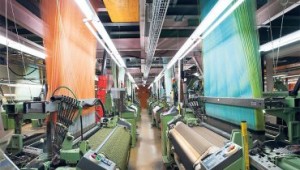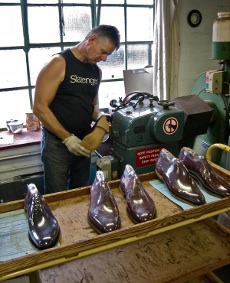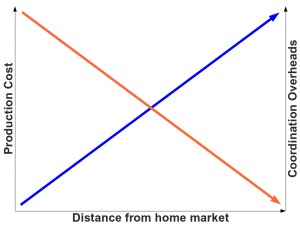
The silk weavery Weisbrod-Zürrer is one of the few remaining witnesses of what once used to be the globally highly successful Swiss silk industry, with a labour force of more than 60’000 employees. For the best part of the 19th, and much of the 20th century the silks ‘Woven in Switzerland’ were synonymous with outstandingly high quality. 2 of the then most influential houses – the Weisbrods and the Schwarzenbachs – had their family’s homes along the left shores of the Lake of Zürich, less than a 30 minutes drive from the city centre.

The Schwarzenbachs went out of business in the late 1980s, and the remainder of the company’s textile library, consisting of vast and historical collections of swatch and pattern books has been very recently donated by the founder family to the archives of the Swiss National Museum [in German]. All that remains now is a building in New York named after the family (‘Schwarzenbach Building’), and the old weavery in Thalwil, which has been partially demolished and partially repurposed.
And now, according to news dating from October 18th 2011 [in German], also the last remaining Swiss silk dynasty, founded in 1825, faces its end after nearly 200 years in business.
Textile production in Europe, so it seems, has once more proven to be financially and strategically unviable. And: no matter how high the quality of products, in the end it is a global market place, and few, if any, are prepared to pay a fair price for quality. What for, after all it’s not meant to last, or is it?!
But there is not only bad news. Taking the previously discussed specific example: A tiny high-tech silk department, with a total of 24 staff (including admin) will remain. This is important news, as it means that the technical knowledge and skills acquired over the course of 2 centuries will – for now – not be lost.
The mini-size however points also into a different direction, one that has been pointed out in March of this year in a New York Times article: "The monolithic single-industry model has evolved as manufacturers see the benefits of being smaller and paying attention to how patterns of consumption, ownership and use are shifting."
In the same article a key quote by SFMade founder Mark Dwight is: “For decades we have developed a culture of disposability — from consumer goods to medical instruments and machine tools. To fuel economic growth, marketers replaced longevity with planned obsolescence — and our mastery of technology has given birth to ever-accelerating unplanned obsolescence. I think there is increasing awareness that this is no longer sustainable on the scale we have developed.”

While what he says is spot on, the more important point is that finally! small scale, specialist, niche manufacturing seems to be coming back – not the least thanks to new retail business models, which couldn’t do without the technologies and platforms that the global network has provided us with.
Paradoxically, the very same technologies that have facilitated the big companies in their going abroad in search of cheaper – if not greener – pastures, are what this new blossoming of local manufacturing is based on. This is because it is a simple, efficient means to cut out middlemen’s margins in favour of the manufacturer’s – crucial in a world where price, despite local pride and ‘coolness factor’, is and remains an important decision factor.
There are of course other factors that must not be forgotten: personalisation of products via web app is one of them. Spearheaded in the early 2000, it is increasingly common place among smaller brands. After all: who doesn’t like to boast with a serial number ‘1 of 1’?
The possibly most important factor, however has to do with public awareness, legal frameworks and the reality big brands encounter ‘out there’: producing 1000s of kilometres away is only viable – practically, technologically, logistically and not the least financially – if the laws of economy of scale apply, thanks to which special precautions (meaning: local staff or frequent visits) can be put in place without them impacting the bottom line significantly. The overhead required to make it work is prohibitive for most companies. And: the farther one goes, the bigger the hurdles, the more overheads are incurred. And overheads cost money (sic!).

For Europe, the whole phenomenon can be summarised, schematically and no doubt leaving out many relevant factors altogether, as depicted in the illustration on the right.
In a world however, in which originality, close contact and awareness of consumer desires are pivotal to survival – not only for goods, but this equally applies to business and job skills – having production close by may actually be advantageous. Quality is less of an issue, communication isn’t, deadlines can be controlled more hands on. Not to speak of vast amounts of implicit knowledge and expectations.
But what about the realistically high cost? Well – it’s a tricky one indeed.
For one cost supposedly is the one most decisive factor for consumers and in procurement. But then again it isn’t as black and white as we think. We spend silly amounts of money for the newest edition of the iPhone – because it is the iPhone, and because it has all we never wanted, or dreamed of, in first place. Fancy iPad covers anyone? Paper eye-lashes in ‘cute’ motives?
The bottom line is: Local manufacturing is viable – if it is innovative, at the pulse of time and delivers quality at a fair price. Not a cheap price, a fair price. In the package, it goes without saying, are our very own standards for ‘green’ productions, fair wages, carbon and water footprint, preservation of skills. It’s not about producing for Zara, Primark or H&M.
It’s about finding those few thousand of consumers that appreciate a good story as much as the have an eye for quality and design.
Competitive? Of course it is, and heavily so. – Just like everything we encounter in the current time and age.

